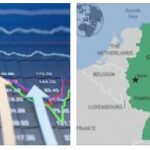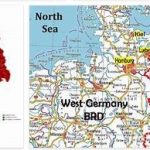Agriculture. – In recent years the cultivated area has had a slight increase, from 7,880,000 ha in 1962 to 8,080,000 in 1973; of these, about 7.5 make up the arable land and over half a million are used for tree crops. The expansion took place at the expense of meadows and pastures (about 5.4 million ha) and forests (7.2). The unproductive area remained more or less unchanged, equal to 16.5% of the national territory. There has also been a certain decrease in the number of farmers, which still exceed 2.5 million, equal to one tenth of the active population. In fact, even if a decrease of population in the big cities has been noticed before, from the countryside the population tends to move towards the centers. The main reason lies in the fact that, despite the various rationalizing measures, the average income of the German farmer is well below half that of other compatriots, which justifies the abandonment of this activity by young people. To some extent, this is not discouraged by the government, which tends to decrease the number of small businesses. It is estimated that after the war the number of these decreased by about 350,000; in 1973 those of less than two hectares were still more than 130,000, but about half of what they were in 1960; those between 2 and 5 hectares had similarly decreased, from 387 to 210,000; even those up to 20 hectares had dropped by a third, to 426,000, while those larger than 20 hectares had increased, from 139 to 198,000. Mechanization is very strong, with about 1.2 million tractors; chemical fertilizers are used abundantly, within the framework of a planning that tends to get the most out of land that before the war was not considered the most fertile in Germany. However, the ratio between employees and territory is still not optimal, with an average of 3.1 ha per farmer compared to over 10 ha in Denmark or the United Kingdom (and about 60 in the USA). In any case, the production of cereals is higher than the Italian one; large increases have had the areas destined to wheat (1.6 million ha) and barley (1.5), whose productions have exceeded 70 and 65 million q respectively. Both have overtaken the once predominant rye, which nevertheless remains widely used in the northern regions for bread making (about 30 million q). The production of oats is currently of the same size, while that of corn is of little importance. The cultivation of potatoes remains fundamental, which has however also registered a contraction and whose production is about 140 million q. The greatest technical progress has been recorded in the cultivation of sugar beet, in which production has increased considerably (about 150 million q) with a small increase in surface area. On the contrary, the area devoted to tobacco contracted, today limited to the best districts of Baden and the Palatinate (85,000 q). Hops are always widespread (over 300,000 q), requested by one of the largest beer industries in the world. The sunniest parts of the Rhine, Main, Neckar and Moselle valleys give a wine production in quantity (almost 10 million q of grapes and 7 million hl of wine) comparable to that of Portugal, higher than those of Greece, Yugoslavia or Romania. Also in the fruit and vegetable sector some productions are at a European level, such as cabbages, apples, cherries, plums. In the zootechnical patrimony the number of cattle remained unchanged (about 13.5 million), while pigs had a slight increase (over 20 million); sheep are decreasing slightly, while poultry animals are growing strongly (well over 100 million). The significant production of meat and dairy products is however insufficient for national needs. Forest exploitation is rather intense, with a production of over 30 million m 5 million) the number of cattle, while pigs increased slightly (over 20 million); sheep are decreasing slightly, while poultry animals are growing strongly (well over 100 million). The significant production of meat and dairy products is however insufficient for national needs. Forest exploitation is rather intense, with a production of over 30 million m 5 million) the number of cattle, while pigs increased slightly (over 20 million); sheep are decreasing slightly, while poultry animals are growing strongly (well over 100 million). The significant production of meat and dairy products is however insufficient for national needs. Forest exploitation is rather intense, with a production of over 30 million m3. To complete the picture of food production, fishing was not increased, and indeed production in the decade decreased to below 500,000 tons; the flotilla has about 3000 units.
Mining production and energy sources. – Coal production has experienced a steady decline, falling below 100 million tonnes in 1973. In practice, only the Ruhr field is able to compete, qualitatively and in terms of costs, with foreign productions. The same is not the case in the Saar and Aachen fields, where indeed there is some unemployment. The activity tends to be limited to deposits that are easier and more mechanizable to extract, but compared to the others, the Ruhr benefits greatly from the ease of transport offered by the waterways. On the other hand, the production of lignite remained constant, which is therefore now equivalent to that of coal. The most used deposit is the very large one near Cologne, which has the advantage of being so shallow that it is exploited in the open, with highly mechanized techniques. To make the landscape of the no longer active mining areas less desolate, the government ensures that at the end of the activity the cavities are filled with water or trees. Minor downturns have been recorded in the extraction of metal ores (iron, lead, zinc), which however are always largely insufficient. Some progress has taken place in the hydrocarbon sector, where new fields have been discovered in Lower Saxony (Ems basin). The production of oil (over 6 million t) is the largest in Western Europe, while that of gas (20 billion t lead, zinc), which are however always largely insufficient. Some progress has taken place in the hydrocarbon sector, where new fields have been discovered in Lower Saxony (Ems basin). The production of oil (over 6 million t) is the largest in Western Europe, while that of gas (20 billion t lead, zinc), which are however always largely insufficient. Some progress has taken place in the hydrocarbon sector, where new fields have been discovered in Lower Saxony (Ems basin). The production of oil (over 6 million t) is the largest in Western Europe, while that of gas (20 billion t3) has recently been overtaken by the Dutch and British ones (fields in the North Sea, where BRD also carries out boreholes). Oil consumption has seen huge increases, tending to become the major source of energy. A program for the construction of nuclear power plants has also been launched: a Euratom laboratory has been operating in Karlsruhe for several years, while the first production plants are from 1966. The largest plant in operation is that of Biblis (1200 MWe) in N Mannheim, inaugurated in 1974. The other major ones are in Obrigheim and Gundremmingen; two other plants are under construction at the latter, for a total of 2500 MWe. The percentage of atomic energy on the total produced (about 275 billion kWh) slightly exceeds 3%, and is about to reach the quantity due to hydroelectric plants, all located in the Alpine sector. Meanwhile, coal still provides almost 35% of the electricity and a further 25% is obtained from lignite. The part of the hydrocarbons is already of this order of magnitude; probably, after the 1973-74 crisis, it will not increase by much.
Industrial activities. – According to ANSWERMBA, the industrial development of the BRD has become proverbial, but in recent years there have been only structural improvements, with even a reduction in the number of employees. Indeed, it has dropped from over 13 million in 1970 to about 12.8 million in 1973. What is naturally always on the rise is productivity per employee; for the total of wages compared to the 1962 = 100 index it reached 160 in 1973, while only for the blue-collar workers it reached 190. With the fears of a recovery in the war gone away, rationalization through company mergers proceeded to full pace. Almost 100,000 companies currently operate, including those considered small, with less than 50 employees, there are 75,000; they employ a total of 11% of the workforce and provide 10% of the turnover. Medium-sized companies, up to 500 employees, there are about 20,000, employ 37% of the workforce and provide 35% of turnover. The largest firms, ie the remaining 5%, employ 51% of the workers and supply 54% of the product. The system of Konzerne, formidable complexes connecting numerous production plants integrated horizontally and vertically, with a huge commercial and financial organization. These actually form the basis of the German industrial economy, which supplies more than 52% of the national product. The steel industry currently produces over 50 million tonnes of steel and 40 million tonnes of cast iron and ferroalloys. Other strong metallurgical productions are those of aluminum, lead, zinc, magnesium. Another sector of large Konzerne it is the chemical one, where the major German industries (in Frankfurt, Leverkusen, Ludwigschafen) are among the largest industrial complexes in the world. The petrochemical refineries have had a strong boost in this sector; in this regard, it should be noted that one of the great petrochemical sectors, that of the Middle Rhine and Bavaria, is supplied with crude oil through oil and gas pipelines departing from Mediterranean ports (Marseille-Karlsruhe, Genoa-Ingolstadt, Trieste-Ingolstadt). The mechanical sector has always had significant development (cars, motorcycles, bicycles, agricultural machinery and industrial machinery in general); the largest German industry is in fact the Volkswagen car manufacturer. In third place in the world in terms of the number of cars produced, BRD is in first place as an exporter. Not too flourishing was the shipbuilding industry, which the government has had to support several times. On the other hand, the development of the electrical and electronic sector was very strong; also in this case the greater Konzern is one of the largest complexes in the world. The production of household appliances of all kinds is very high and of quality, but also the production of the electronic sector (where the penetration of US capital is very strong). The textile industry is always relevant, with over 500,000 employees.
Routes of communication and foreign trade. – The political division of the German territory has negatively influenced the long-range communication routes in the east-west direction (motorways and railways to Berlin, rivers and navigable canals). On the other hand, the north-south axes have increasingly developed; for heavy transport the BRD uses inland waterways more than any other European country and the network extends for over 4350 km. The railway network reaches almost 30,000 km, while the road network exceeds 165,000 (of which 5,260 km of motorways). The trade balance is always highly active, thanks to a formidable export of industrial products of all kinds, with which only the USA and Japan are able to compete. The movement occurs mostly with the countries of the Western bloc and to a lesser extent with the socialist countries and the Third World.








